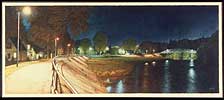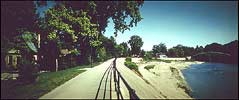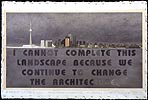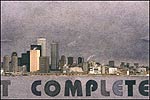The work in
this “Early 1980's” Wing of the Gallery at www.GerardPas.com
denotes a fundamental change in the life of Gerard Pas and his art. At first
glance one might even conclude that this change is reactionary, although
it is as outlandish to Gerard's previous works of the seventies
as it is honest to the direction it will take him in the decades to come.
After wrestling with a "monkey on his back," Gerard moved from
his homes in Amsterdam and New York City, to the small rural hamlet of Eck
en Weil on the Rhine River in The Netherlands (Betuwe, Holland). This move
was precipitated through various outside influences as well as his discovery
that he was a 'spiritual being'. Many artists, had been stating for years
that the “Cartesian model” (the critical historical method)
ignored the fact that there was or at least could be a spiritual realm,
as well as the 'empirical' one we all know. While living in Amsterdam, Gerard
had become disillusioned with not only the 'punk movement' of which he was
very actively involved at its inception but also with the direction of his
work. He had come to see that, if as he said “Art is a method of
catharsis - by raising your demons to the forefront they can be exorcised
or at least dealt with.” he had purposely elected to ignore the
new demons which this process had cultivated in him. More concretely as
a punk Gerard and his cohorts used a language of pain or angst. If something
was to be considered beautiful, it had to be riddled with separation, alienation
or just convey the travail of life. Up until then and rather ironically
what was ugly was considered beauty and vice versa. In the Dadaist tradition
Gerard sung along with the homily that all old art should be abandoned and
the new celebrated for being the only art that mattered. Regrettably, "let
us first destroy or purge the old to give life to the new" is the
refrain of this song. But what of Beauty? Beauty was the one demon which
he could not evade, as it is everywhere in life and also not willing to
surrender to the dark.
Gerard had come to realize that the pain inflicted on himself during his
performance's of the seventies,
did have a cathartic effect. Based on the legacy of his work up until that
date he began a sojourn which would take him from idealistic investigations
of Beauty and the discovery of his spiritual self. What he found at first
was the joy of new discovery and then bitter disappointment in the cognizance
that Beauty was indeed relative, fleeting and temporal.
It is important to state that the work of the early eighties was never held
out to be a turning away from his earlier investigation of the seventies.
The work seen below, particularly the landscapes, were never exhibited alone
and were always displayed opposite to documentation from his earlier performances,
and photographs of the seventies. They are to be considered works in juxtaposition,
which hopefully conjure up a dialectical discourse between pain and/or joy,
and the not so easily defined areas in between.
These new works would cause Gerard to mature and to see that those levels
of consternation or bliss can almost be measured by the same criteria. The
work below would set the framework for him to return to themes he had earlier
dealt with during the seventies, but now informed with the knowledge that
beauty or truth are not exclusive (from thesis to antithesis to synthesis).
They are the seeds for his series of work titled “Red-Blue
Works,” which brought Gerard back into the attention of
the world as his earlier works had done with their intensity. |














